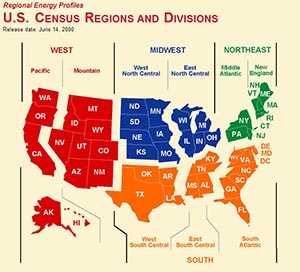It goes against popular belief, but a recent study from the University of Alabama at Birmingham (UAB) shows that the southern region of the United States is not the fattest part of the country.
 |
| U.S. Census Regions and Divisions |
“The obesity epidemic is overwhelming the U.S., and there’s this strong perception that Mississippi and Alabama are number one and number two in obesity — fighting for last place,” said George Howard, Dr.P.H., professor in the Department of Biostatistics in the UAB School of Public Health.
Howard said that according to data from the long-running REGARDS (Reasons for Geographic and Racial Differences in Stroke) study, the West North Central part of the country, which includes North and South Dakota, Minnesota, Nebraska, Iowa, Kansas and Missouri, is the fattest area — with a 41 percent obese population. These findings were recently published online by the journal Obesity.
“We were thinking since people living in the South are generally more hypertensive and have higher rates of diabetes and stroke, it would be the fattest region,” Howard explained. “But when we looked at our data, people in the South were really not the fattest.”
The study grouped states into regions used by the U.S. Census Bureau in order to compare data to the National Health and Nutrition Examination Survey (NHANES) to confirm the findings from REGARDS. Mississippi and Alabama are part of the East South Central region of the U.S., which also includes Tennessee and Kentucky. REGARDS ranked the region fifth out of nine regions with 34 percent obese, and the NHANES showed that it was seventh out of eight regions with only 31 percent obese (NHANES ranks fewer regions than REGARDS because NHANES has fewer measurements collected for reporting the New England states of Maine, New Hampshire, Vermont, Massachusetts, Rhode Island and Connecticut).
|
“We were thinking since people living in the South are generally more hypertensive and have higher rates of diabetes and stroke, it would be the fattest region,” Howard explained. “But when we looked at our data, people in the South were really not the fattest.” |
Also, both REGARDS and NHANES used data sets gathered from measured height and weight. Howard said the state-by-state obesity rankings typically cited are from data that used self-reported height and weight information.
“Asking someone how much they weigh is probably the second worst question behind how much money they make,” Howard explained. “From past research, we know that women tend to underreport their weight, and men tend to over-report their height.”
Howard said as far as equivalency between the self-reported and measured data sets, the East South Central region showed the least misreporting.
“This suggests that people from the South come closer to telling the truth than people from other regions, perhaps because there’s not the social stigma of being obese in the South as there is in other regions,” Howard said.
Howard said it is important that obesity rankings be correct, as a lot rides on these numbers.
“A lot of decisions are based on geographic differences in obesity – such as how much federal funding goes to regions to fight obesity,” Howard said. “Typically, the South has received the most because others have said it’s the fattest, but it might not be. The South has had very bad obesity problems, but not worse than some other regions.”